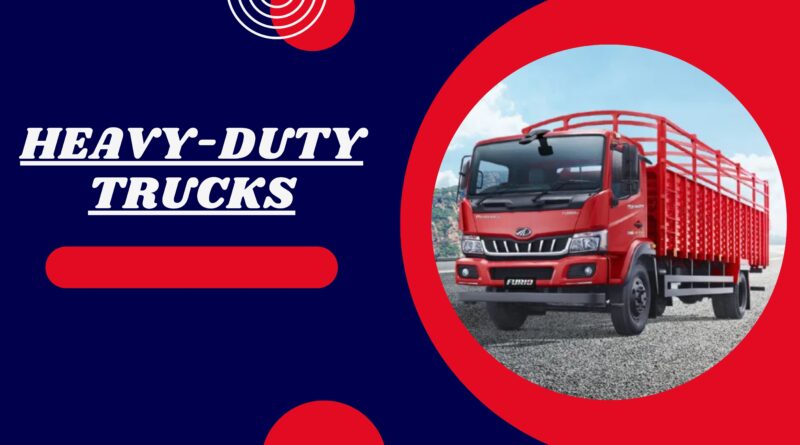Heavy-Duty Trucks & Supply Chain: Handling Challenges 2024
In 2024, the global supply chain for the heavy-duty truck industry will undergo very rough times. Demand is beginning to double, fuel is on a cost escalation, and driver shortages are becoming major, with tough norms. Creativity and planning are what will put the Ashok Leyland or Mahindra truck ahead of the game. In the blog, you will learn how the industry addresses the supply chain issues to have the best and most responsive transport.
Why Consider Heavy-Duty Trucks For Supply Chain?
Long-haul vehicles are essential to supply chain systems since they help transport goods over the intended distance within the supply chain. Moreover, they ensure that businesses keep running. It’s important in the supply chain in 2024. Further, heavy goods provide flexibility in haulage, be it perishable goods or heavy equipment, making an industry or business convenient for them.
Growing Customer Demand
As such, the demand for heavy-duty trucks is snowballing. E-commerce is doing it due to the surge during the pandemic. Therefore, more trucks are needed to meet the deliveries on time. However, the quantity of new trucks in supply still needs to meet the demand. This misfit leads to constraints in the supply of certain goods as manufacturing and delivery are dragged down, and there are shortages of components like semiconductors.
Rising Fuel Costs & Environmental Concerns
Rising fuel costs is a major concern which includes skyrocketing fuel prices, directly impacting operational costs. Heavy-duty trucks consume a lot of fuel; thereby, they are highly affected by the truck price rise. All these translate into high costs that hit the bottom line of logistics businesses. Another layer of complexity comes with environmental concerns. The governments and their consumers apply pressure to deliver greener solutions that reduce emissions and follow sustainable practices.
Technological Growth
Technology is a potential solution to all these challenges. Advanced telemetry management enhances the planning of the route, therefore lowering fuel usage and, hence, fewer emissions. The systems also facilitate better management of the vehicles for improved efficiencies. Electric and hybrid trucks, meanwhile, are a huge paradigm shift. Moreover, electric and hybrid trucks promise lesser dependency on fossil fuels and cleaner emissions. Their utilization could be higher because they are expensive to purchase, and limited infrastructure endorses that concept.
Driver Shortages and Workforce Challenges
There is always a need for more drivers within the industry. A lot of drivers are retiring, and few young people are joining the profession. Consequently, businesses always need help finding equipped drivers. Other facts are that the job involves many long hours, resulting in fatigue and declining productivity. These have to be addressed through better working conditions and better incentives.
Regulator Changes and Compliance
The new regulations aim at better standards of safety and environment, but considering compliance is expensive. Most businesses will have to invest in new technologies and training to meet these requirements. Also, what will vary from one region to another is what is applicable to the argument of regulations. Moreover, it only complicates the operations of cross-border businesses further. Further, you must stay compliant and require constant vigilance and adaptation.
Strategies for Overcoming Adversity
Read the following strategies for overcoming supply chain management challenges done by heavy-duty trucks below.
1. Encouraging Innovation
Innovation is in seeking ways to waive these challenges. Businesses need to invest in research and development in order to come up with new solutions. For example, self-driving trucks will change how this economy will work without depending on a human driver. Developing Stronger Partnerships
2. Collaboration & Alliances
Generally, businesses should establish alliances with suppliers, technology providers, and other stakeholders. These alliances assist them in navigating easily out of any challenge. By dealing with such alliances, one can get shared resources and devise solutions for the challenges.
3. Enhancing Workforce Development
Businesses need to invest in workforce development in order to break the cycle. Moreover, remedies for this include training programs, working conditions, competitive salaries, and benefits. Besides, such strategies as attracting new talents or retaining drivers may be essential for the sake of the industry’s future.
Opportunities of the Future Heavy-duty trucks
Operating future supply chains has the potential to add a lot of value to the industry. Moreover, there is a flurry at present. This industry will grow with technology improvements, a focus on sustainability, and strategic partnerships. Responding businesses will be positioned to thrive, serve customers, and remain competitive in new markets.
Conclusion
The challenges of the heavy-duty trucking industry in 2024 comprise factors that influence the supply chain. These include rocketing fuel prices, driver shortages, changing regulations, and the impact of increasing demand. A bright future emerges for those who adapt and pre-invest in new solutions. The heavy-duty Mahindra or Ashok Leyland truck will always be the linchpin of supply chains. The industry will continue growing in efficiency, sustainability, and resilience to respond to the changing world’s needs.

